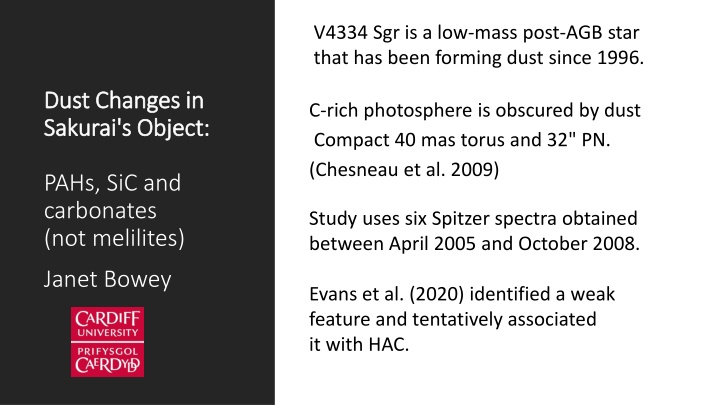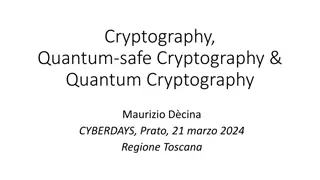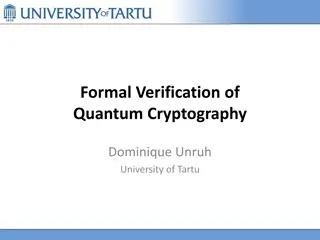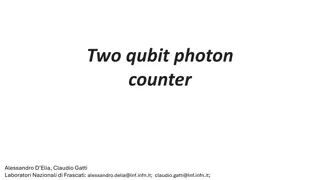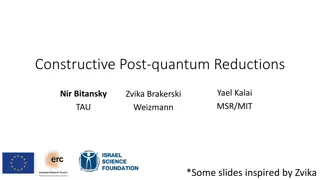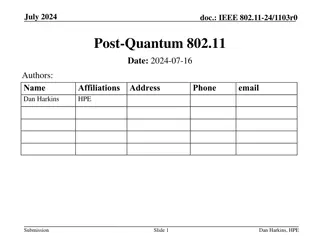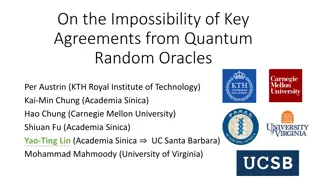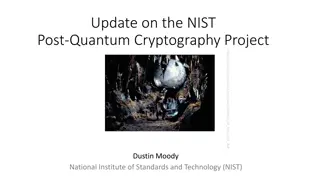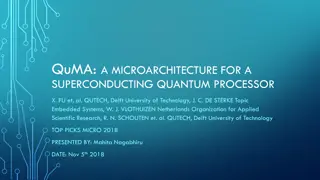Cryptography in a Post-Quantum World: Alice, Bob, and Eve
The evolution of cryptography in the age of quantum computing, exploring symmetric and public-key crypto, classical vs. quantum computers, quantum algorithms, and the challenges and progress in quantum computing development.
Download Presentation

Please find below an Image/Link to download the presentation.
The content on the website is provided AS IS for your information and personal use only. It may not be sold, licensed, or shared on other websites without obtaining consent from the author.If you encounter any issues during the download, it is possible that the publisher has removed the file from their server.
You are allowed to download the files provided on this website for personal or commercial use, subject to the condition that they are used lawfully. All files are the property of their respective owners.
The content on the website is provided AS IS for your information and personal use only. It may not be sold, licensed, or shared on other websites without obtaining consent from the author.
E N D
Presentation Transcript
V4334 Sgr is a low-mass post-AGB star that has been forming dust since 1996. Dust Changes in Dust Changes in Sakurai's Object: Sakurai's Object: C-rich photosphere is obscured by dust Compact 40 mas torus and 32" PN. (Chesneau et al. 2009) PAHs, SiC and carbonates (not melilites) Study uses six Spitzer spectra obtained between April 2005 and October 2008. Janet Bowey Evans et al. (2020) identified a weak feature and tentatively associated it with HAC.
Bowey (2021): absorption features near 6 m grew... Bowey (2021): absorption features near 6 m grew... 6.9 m absorption seen in YSOs and molecular clouds and associated with ices.
Feature does not look like Hydrogenated Amorphous Carbon (HAC) Sakurai has no absorption at 5.6 to 5.8 m
What could the dust be? What could the dust be? 50 nm-sized PAHs + 20 m-sized SiC overtone band ? + ? No H2O ice No carbonates No carbon candidate Fit Oxygen-rich candidate: 12 m-sized melilites Ca2(Al,Si)2O7 (overtone band Bowey & Hofmeister 2005)
Bowey (2021) argued that melilite could come from grains in the PN. However, based on one laboratory spectrum .. New laboratory spectra taken by Anne Hofmeister (Washington University St Louis, USA).
Lab data for carbonates: Bowey & Hofmeister 2022 MNRAS, 513, 1774 Magnesite, ?????, ~ 27000 cm2g-1 True melilite (Ca,Mg)(Al,Si)??, ~15 cm2g-1
PAHs, PAHs, SiC SiC and Carbonate (magnesite?) and Carbonate (magnesite?) Melilite Fits Better fit qualities PAH ( 10 %) MgCO3 ( 10 %) SiC consistent, 10 50 % higher. No big silicate grains modelled
Noisier long wavelength data Obtained fit with: PAH and carbonate from NIR fits Diffuse medium silicates (Cyg OB2 no. 12) Optically thin SiC emission Fit
SiC emission from nm-sized grains decreased, then increased rapidly between 21 30 April 2008 and more slowly to October 2008. 10 m silicate absorption decreases between epochs 3 5 (October 2007-2008)
Growth in Dust Mass Growth in Dust Mass Emission: Dust mass increased (K-band; Evans et al. 2020) --rapidly increase April June 1999 nm SiC emission increased rapidly in 04/2008 Absorption features: nm-sized PAH abundance increased 0.1 m-sized magnesite abundance increased 0.3 m-sized silicates decreased 10/07 10/08 25 m-sized SiC grains increased uniformly with magnesite (black), not with melilite. NIR changes appear in MIR 9 years later.
Dust: column densities and mass estimates Dust: column densities and mass estimates Mass Density /10 6g cm 2 Number Density/ cm 2 50 AU torus at 3.8kpc /? Carbonaceous Dust PAH X 10 uncertainty 220 640 108 1.1 3.3 ?? ? 48 150 ?? ? PAHs (53 nm) 1.3 3.7 SiC (25 m) 54 167 1100 3300 9500 4400 15000 108 SiC (3 nm) 0.082 0.13 1.2 2.8 108 1.1 2.4 ?? ? MgCO3(0.15 m) 1.2 2.8 Oxygen-rich Dust 6.5 4.7 108 Astrosilicate (0.3 m) 58 42 Torus masses: PAHs Carbonates 10 9 ? Large SiC grains : up to 10 7 ?
Astrophysics Summary: Sakurais Object. Astrophysics Summary: Sakurai s Object. Bowey, J. E. 2021, MNRAS, 505, 568 Bowey & Hofmeister 2022 MNRAS, 513, 1774 nm-sized SiC emission: 2007 21 30 April 2008 April - October 2008. Absorption features : Increase in 53 nm PAH and carbonate (MgCO3) abundance from 2005 2008 SiC grains with meteoritic sizes (25 m) Astrosilicate decreased by 28 % between October 2007 and October 2008. Masses if located in 50AU torus in October 2008: PAH: 3.3 10 9? MgCO3 2.4 10 9? SiC (25 m) :150 10 9 ?
Implications: Implications: Sakurai s Object has been key to associating carbonates with the 6.9 m band. Carbonates observed: FIR observations (e.g. NGC 6302 Kemper et al. 2002) Meteorite samples associated with aqueous alteration in parent bodies. IDP spectra (Sandford & Walker 1985). Modelled comet Deep Impact experiment (Lisse et al. 2007) How are Sakurai s carbonates created? Connected with astrosilicate decrease? Theory : condense below 700K in O-rich stars (Ferrarotti & Gail 2005) no O in C H atmosphere. Experiment: Formation from older dust? 6 Bar pressure?????? + ??? (Day et al. 2013)
